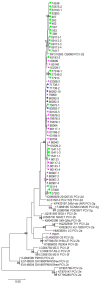Evidence of Porcine Circovirus Type 2 (PCV2) Genetic Shift from PCV2b to PCV2d Genotype in Sardinia, Italy
- PMID: 38005836
- PMCID: PMC10674684
- DOI: 10.3390/v15112157
Evidence of Porcine Circovirus Type 2 (PCV2) Genetic Shift from PCV2b to PCV2d Genotype in Sardinia, Italy
Abstract
Porcine Circovirus type 2 (PCV2) is the etiological agent of a disease syndrome named Porcine Circovirus disease (PCVD), representing an important threat for the pig industry. The increasing international trade of live animals and the development of intensive pig farming seem to have sustained the spreading of PCVD on a global scale. Recent classification criteria allowed the identification of nine different PCV2 genotypes (PCV2a-i). PCV2a was the first genotype detected with the highest frequency from the late 1990s to 2000, which was then superseded by PCV2b (first genotype shift). An ongoing genotype shift is now determining increasing prevalence rates of PCV2d, in replacement of PCV2b. In Italy, a complete genotype replacement was not evidenced yet. The present study was carried out on 369 samples originating from domestic pigs, free-ranging pigs, and wild boars collected in Sardinia between 2020 and 2022, with the aim to update the last survey performed on samples collected during 2009-2013. Fifty-seven complete ORF2 sequences were obtained, and the phylogenetic and network analyses evidenced that 56 out of 57 strains belong to the PCV2d genotype and only one strain to PCV2b, thus showing the occurrence of a genotype shift from PCV2b to PCV2d in Sardinia.
Keywords: Porcine Circovirus type 2; genetic shift; phylogenetic analysis.
Conflict of interest statement
The authors declare no conflict of interest.
Figures



Similar articles
-
Phylogenetic analysis of porcine circovirus type 2 in Sardinia, Italy, shows genotype 2d circulation among domestic pigs and wild boars.Infect Genet Evol. 2019 Jul;71:189-196. doi: 10.1016/j.meegid.2019.03.013. Epub 2019 Mar 20. Infect Genet Evol. 2019. PMID: 30904672
-
Global molecular genetic analysis of porcine circovirus type 2 (PCV2) sequences confirms the presence of four main PCV2 genotypes and reveals a rapid increase of PCV2d.J Gen Virol. 2015 Jul;96(Pt 7):1830-41. doi: 10.1099/vir.0.000100. Epub 2015 Feb 23. J Gen Virol. 2015. PMID: 25711965
-
Genetic and phylogenetic analysis of porcine circovirus type 2 on Jeju Island, South Korea, 2019-2020: evidence of a novel intergenotypic recombinant.Arch Virol. 2021 Apr;166(4):1093-1102. doi: 10.1007/s00705-020-04948-1. Epub 2021 Feb 11. Arch Virol. 2021. PMID: 33570666
-
Porcine circovirus type 2 (PCV2) genotyping in Austrian pigs in the years 2002 to 2017.BMC Vet Res. 2020 Jun 15;16(1):198. doi: 10.1186/s12917-020-02413-4. BMC Vet Res. 2020. PMID: 32539835 Free PMC article.
-
Porcine Circovirus Type 2 (PCV2) Vaccines in the Context of Current Molecular Epidemiology.Viruses. 2017 May 6;9(5):99. doi: 10.3390/v9050099. Viruses. 2017. PMID: 28481275 Free PMC article. Review.
Cited by
-
First Molecular Characterisation of Porcine Parvovirus 7 (PPV7) in Italy.Viruses. 2024 Jun 8;16(6):932. doi: 10.3390/v16060932. Viruses. 2024. PMID: 38932224 Free PMC article.
-
Global Challenges and Advancements in the Management of Pivotal Porcine/Swine Viral Diseases.In Vivo. 2025 Jul-Aug;39(4):1810-1832. doi: 10.21873/invivo.13982. In Vivo. 2025. PMID: 40578970 Free PMC article. Review.
-
Genetic diversity of porcine circoviruses 2 and 3 circulating among wild boars in the Moscow Region of Russia.Front Vet Sci. 2024 Jun 26;11:1372203. doi: 10.3389/fvets.2024.1372203. eCollection 2024. Front Vet Sci. 2024. PMID: 38988985 Free PMC article.
-
A Subunit Vaccine Harboring the Fusion Capsid Proteins of Porcine Circovirus Types 2, 3, and 4 Induces Protective Immune Responses in a Mouse Model.Viruses. 2024 Dec 23;16(12):1964. doi: 10.3390/v16121964. Viruses. 2024. PMID: 39772270 Free PMC article.
-
Molecular Positivity of Porcine Circovirus Type 2 Associated with Production Practices on Farms in Jalisco, Mexico.Viruses. 2024 Oct 19;16(10):1633. doi: 10.3390/v16101633. Viruses. 2024. PMID: 39459964 Free PMC article.
References
-
- Segalés J. Porcine circovirus type 2 (PCV2) infections: Clinical signs, pathology and laboratory diagnosis. Virus Res. 2012;164:10–19. - PubMed
-
- Harding J.C.S., Clark E.G., Strokappe J.H., Willson P.I.E.J. Postweaning multisystemic wasting syndrome: Epidemiology and clinical presentation. J. Swine Health Prod. 1998;6:249–254.
MeSH terms
Grants and funding
LinkOut - more resources
Full Text Sources

